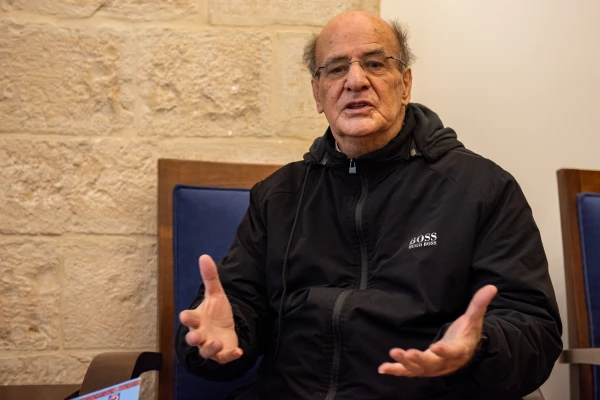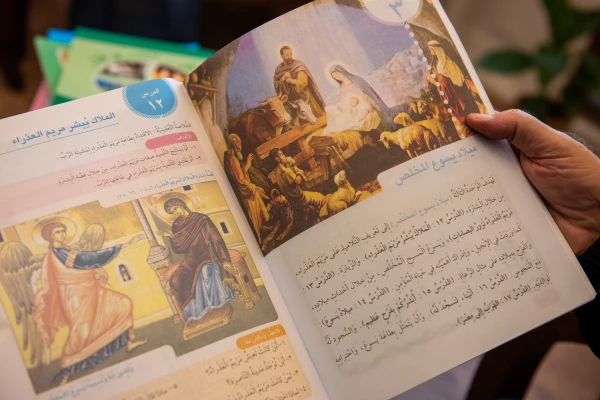Jerusalem, Jan 24, 2024 / 14:00 pm
“To be Christians in the Holy Land means to love God, one’s own tradition, and all other churches,” 80-year-old Father Rafiq Khoury told CNA as the Week of Prayer for Christian Unity began in the Holy Land on Jan. 18. “We are just at the beginning; it is a challenge for the next thousand years.”
Although now retired, Khoury still has an office at the Latin Patriarchate of Jerusalem. Originally from Taybeh — the only all-Christian town in Palestine, which today is famous for its beer — he worked for 35 years in the field of catechesis helping to edit a religious education textbook.

In his long career, Khoury played a significant role in editing an “ecumenical catechism,” which has been adopted since 2000 in public schools of the Palestinian Authority as a textbook for Christian education. Many Christian schools have also adopted the book because it takes into account the ecumenical context inherent to the Holy Land.
“In the Holy Land,” Khoury explained, “catechesis has developed from the very beginning within the school environment rather than the parish. In fact, each Church has its own schools. When the Latin Patriarchate was reestablished in 1847, the church was built for liturgical life, and the school for religious education.” In this context, the editing of a catechism with the participation of representatives from all Christian churches takes on even greater significance.
Over the past 120 years, the educational system has undergone change with the political events of the time — from Ottoman rule to the British Mandate, to the establishment of the state of Israel and the separation of Palestinian territories. It was only with the establishment of the Palestinian Authority in 1994 that a specifically Palestinian curriculum was created, including religious instruction.
Khoury, born in 1943, has lived through many of these changes.
“The Six-Day War was a shock for Arab Christian communities throughout the Middle East. Christians began to question: Who are we? What is our witness in the Holy Land? Why did God want us here? All of this has an impact on catechesis,” that is, “on how to present the Christian message and its relevance to the challenges of the present,” he said.
These were also the years of the Second Vatican Council, which gave a new focus to the way faith is conveyed.
In this context, Khoury’s mission emerged. He was sent to study in Rome and upon his return worked for 10 years editing a Catholic catechism for the Latin Patriarchate. Then, in the 1990s, he was asked to compile a catechism for the Palestinian school system in agreement with other Christian denominations and in partnership with the Ministry of Education and Higher Education. This decade-long endeavor placed him side by side with colleagues from other churches.
“First of all,” Khoury recounted, “we thought about the general structure and decided to divide the subject into three main chapters: doctrinal, liturgical, and practical, concerning lifestyle.”

This cycle of three chapters is repeated four times over the course of 12 years of study, becoming increasingly comprehensive in relation to the age of the students. The books present topics by offering a passage from the Bible or the Gospel — according to the ecumenical translation, also available in Arabic — and practical situations and advice where the students can relate their experiences. There is also a section dedicated to exercises.
“We did not encounter major difficulties because, in the end, we have a common faith in Jesus Christ that we believe in, celebrate, and live,” Khoury said. “The main difficulties were regarding the primacy of the pope, which other churches do not accept, and on the sacraments, which are especially different in the Protestant world, both in number and meaning.” The solution, he said, was to “explain, in the first case, the different ecclesial systems, and in the second, what the sacraments mean for the various churches.”
The same applied to the person of the Virgin Mary.
“We are witnessing an evolution in Protestant churches: There is an increasing acceptance of the figure of Mary, even if only as a biblical figure, and not according to the theology developed in the Catholic Church and the Orthodox Church,” the priest explained. “That’s why we chose to highlight the biblical figure of Mary.” Other points of dialogue and mediation included images, saints, and dogmas.
(Story continues below)
For Khoury, the book is a tool that, in the hands of young people, can truly help them live an authentic Christian dimension without losing their individual specificity and belonging. “One cannot be a Christian in the Holy Land without engaging with other churches. It is important to be anchored in one’s own church while being open to other churches, to have an awareness of one’s identity but be open to the other. Others exist, and they too have a long history that we must learn to know, respect, and love,” he said.
Ecumenism is a challenge, not only in schools but also in the broader Christian life, according to Khoury. “Communities are still closed in on themselves, and often, it is difficult even to consider the presence of others,” he said. Among the churches, “there are more friendly relationships, but not yet true ecumenism: The problems are not really shared and discussed together.”
At the same time, Khoury emphasized that “we must understand that it takes time. In the Holy Land, we have faced many obstacles to inter-church relations, and we carry this wound in our hearts. We have fought against each other, and now we must love one another. It takes time for this vision to enter the hearts of the Christians of the Holy Land, but the process has begun.”






